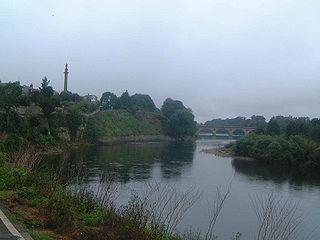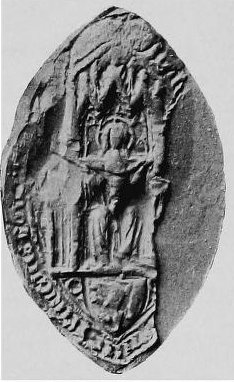Related Research Articles

A priory is a monastery of men or women under religious vows that is headed by a prior or prioress. Priories may be houses of mendicant friars or nuns, or monasteries of monks or nuns. Houses of canons regular and canonesses regular also use this term, the alternative being "canonry".

Coldstream is a town and civil parish in the Scottish Borders area of Scotland. A former burgh, Coldstream is the home of the Coldstream Guards, a regiment in the British Army.
Joanna is a feminine given name deriving from Koinē Greek: Ἰωάννα, romanized: Iōanna from Hebrew: יוֹחָנָה, romanized: Yôḥānāh, lit. 'God is gracious'. Variants in English include Joan, Joann, Joanne, and Johanna. Other forms of the name in English are Jan, Jane, Janet, Janice, Jean, and Jeanne.
A double monastery is a monastery combining separate communities of monks and of nuns, joined in one institution to share one church and other facilities. The practice is believed to have started in the East at the dawn of monasticism. It is considered more common in the monasticism of Eastern Christianity, where it is traceable to the 4th century. In the West the establishment of double monasteries became popular after Columbanus and sprang up in Gaul and in Anglo-Saxon England. Double monasteries were forbidden by the Second Council of Nicaea in 787, though it took many years for the decree to be enforced. Double monasteries were revived again after the 12th century in a significantly different way when a number of religious houses were established on this pattern among Benedictines and possibly the Dominicans. The 14th-century Bridgittines were purposely founded using this form of community.

Agnes of Montepulciano was a Dominican prioress in medieval Tuscany, who was known as a miracle worker during her lifetime. She is honored as a saint by the Catholic Church.

Arthington Priory was an English monastery which was home to a community of nuns in Arthington, West Yorkshire, founded in the mid-12th century. The priory land is occupied by a residence called "Arthington Hall", which was built around 1585, and little, if anything, remains of the priory. The site of the priory church is possibly now occupied by a farmhouse called The Nunnery. The community was the only one of nuns of the Cluniac congregation in Yorkshire and one of two in England. It was established through a grant by Peter de Arthington.

The Abbey of Santa María la Real de Las Huelgas is a monastery of Cistercian nuns located approximately 1.5 km west of the city of Burgos in Spain. The word huelgas, which usually refers to "labour strikes" in modern Spanish, refers in this case to land which had been left fallow. Historically, the monastery has been the site of many weddings of royal families, both foreign and Spanish, including that of Edward I of England to Eleanor of Castile in 1254, for example. The defensive tower of the Abbey is also the birthplace of King Peter of Castile.
Amesbury Priory was a Benedictine monastery at Amesbury in Wiltshire, England, belonging to the Order of Fontevraud. It was founded in 1177 to replace the earlier Amesbury Abbey, a Saxon foundation established about the year 979. The Anglo-Norman Amesbury Priory was disbanded at the Dissolution of the monasteries and ceased to exist as a monastic house in 1539.

Mary, Mediatrix of All Grace is a Marian apparition that allegedly took place in the Carmelite Monastery of Lipa, Batangas, Philippines, to a former Carmelite postulant, Teresita Castillo. The original statue associated with the apparition is currently enshrined at the monastery.

Markyate Priory was a Benedictine priory in Bedfordshire, England. It was established in 1145 and disestablished in 1537.
Elcho Priory was a medieval Cistercian priory in Perthshire, Scotland, dedicated to the Virgin Mary.

Ana de Jesús, translated into English as Anne of Jesus, was a Spanish Discalced Carmelite nun and writer. She was a close companion of Teresa of Avila, foundress of the Carmelite reform and served to establish new monasteries of the Order throughout Europe. Known as a mystic and for her writings on prayer, she has been declared Venerable by the Catholic Church.

The Liebenau monastery was a Dominican monastery. It was located outside the city gates of Worms in today's Worms-Hochheim district.

Sybil Montagu or Montague or de Montague or Montacute was a daughter of John de Montagu, 1st Baron Montagu and his wife Margaret de Monthermer. At an unknown date she entered Amesbury Priory and became a nun, then in 1391 was elected the monastery's prioress. Her vigorous government led to a few stormy years in the monastery, in the period when the conflict between Richard II and his eventual successor Henry IV came to a head. She weathered that and later storms and died as prioress in 1420.

The Keldholme Priory election dispute occurred in Yorkshire, England, in 1308. After a series of resignations by its prioresses, the establishment was in a state of turmoil, and the Archbishop of York, William Greenfield, appointed one of the nuns to lead the house. His candidate, Emma de Ebor', was deemed unacceptable by many nuns, who undermined her from the start to the extent that she resigned three months later. The archbishop, forced to find another candidate, claimed that he was unable to do so from within the priory and appointed Joan de Pykering from nearby Rosedale Priory. It is likely that Keldholme saw de Pykering as an intruder, and it seems to have reacted against her in much the same way as to her predecessor.

The Littlemore Priory scandals took place between 1517 and 1518. They involved accusations of sexual immorality and sometimes brutal violence among the Benedictine nuns and their prioress at St Nicholas' Priory in Littlemore, in Oxfordshire, England. The priory was very small and poor, and had a history of troubled relations with its bishops, dating back to the mid-1400s. The scandal that came to light in 1517, however, became enough of a cause célèbre to contribute to the priory's eventual suppression in 1525. Katherine Wells, the prioress of Littlemore at that time, ran the priory with strict and often violent discipline. She was accused of regularly putting nuns in the stocks for extended periods, as well as physically assaulting them. She also had a baby by the priory's chaplain and had pawned the priory's jewels to pay for the child's upbringing. She entertained men in her parlour, even after the bishop had been made aware of the accusations, which involved heavy drinking. At least one other nun also had a child. On one occasion a number of the nuns broke out of the priory through a window and escaped into the surrounding villages for some weeks.

Cecilia Cesarini (1203-1290), also Caecilia, was a Dominican nun. Cecilia, described as "a high-spirited young Roman", was born into the Cesarini family, a well-established family of the minor nobility. The reason she entered into a religious life is unknown.
Elizabeth Lorde was an English prioress of Wilberfoss. During the Dissolution of the Monasteries she surrendered Wilberfoss Priory as required by law and accepted a pension.
Joan Harkey was the last English prioress of Ellerton Priory in Swaledale in Yorkshire.
Elizabeth Cressener was an English prioress of the Dominican Dartford Priory in Kent. One of her nuns was a Princess, daughter of Edward IV. She lived to see the start of the Dissolution of the Monasteries.
References
- 1 2 McGuire, Thérèse B (1988). "Monastic Artists and Educators of the Middle Ages". Woman's Art Journal. 9 (2): 3–9. doi:10.2307/1358313.
- ↑ Bluestone, Natalie Harris, ed. (1995). Double vision : perspectives on gender and the visual arts. Madison [u.a.]: Fairleigh Dickinson University Press [u.a.] p. 71. ISBN 0838635407.
- 1 2 Williams, Marty Newman; Echols, Anne (1993). Between pit and pedestal : women in the Middle Ages . Princeton, NJ: Markus Wiener Pub. p. 232. ISBN 0910129339.